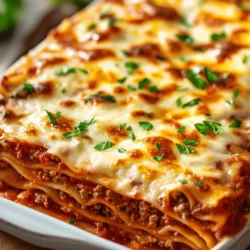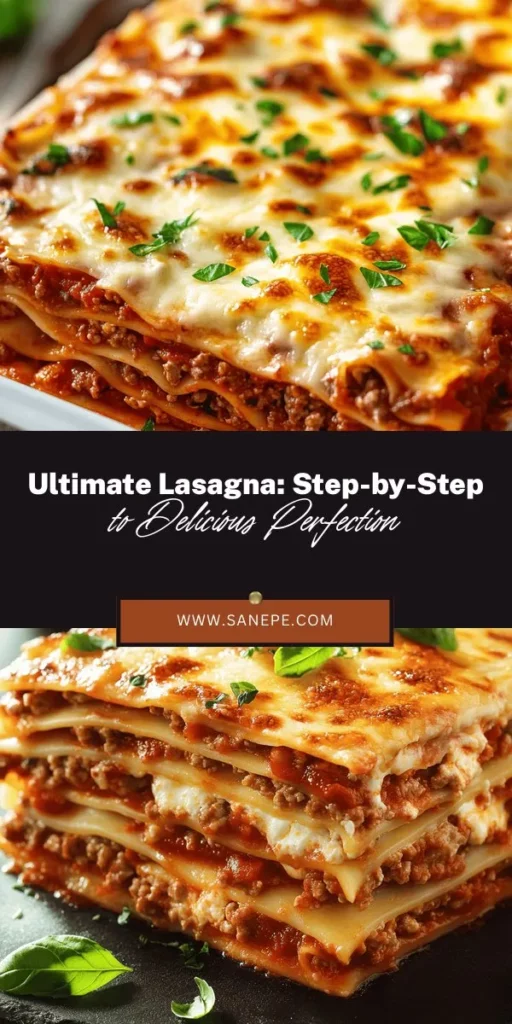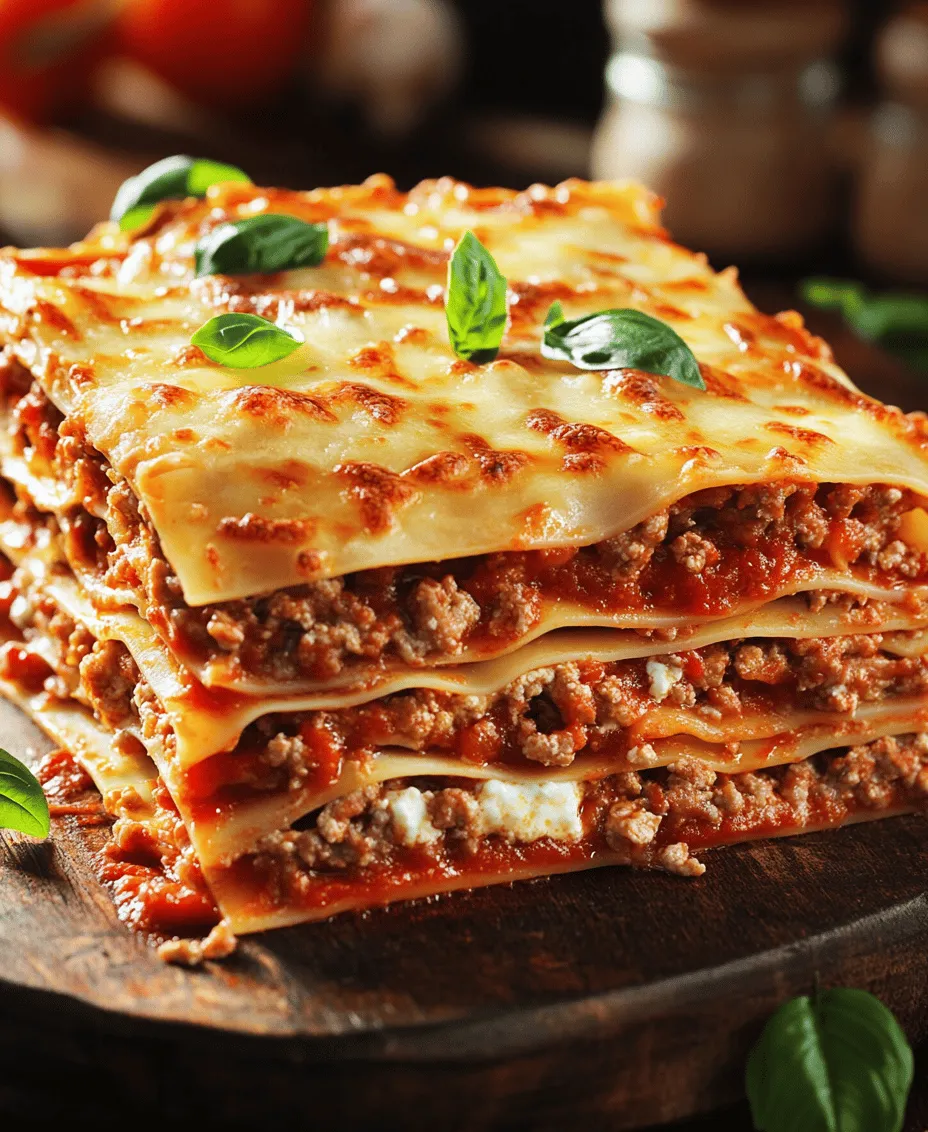Introduction
Lasagna is more than just a meal; it’s a cherished tradition that brings families together around the dinner table. This classic Italian dish has gained immense popularity worldwide, beloved for its rich layers of pasta, savory meat, and creamy cheese. Whether served at a festive gathering or a cozy family dinner, lasagna is synonymous with comfort food, evoking memories of shared moments and hearty laughter.
In this article, we will explore the “World’s Best Lasagna Recipe,” a culmination of flavors and textures that will elevate your culinary skills and impress your guests. This recipe promises to deliver the perfect balance of savory meat, creamy cheese, and tangy marinara sauce, all nestled between sheets of pasta. Follow along for detailed instructions and expert tips to ensure your lasagna comes out perfectly every time.
Understanding Lasagna: The Classic Italian Dish
Lasagna’s roots trace back to Ancient Greece, where a dish called “Laganon,” made of layers of pasta and sauce, was first documented. However, it was in Italy where lasagna truly evolved into the beloved dish we know today. Each region of Italy boasts its own unique variations, often influenced by local ingredients and culinary traditions. In Bologna, for example, a traditional lasagna is made with a rich Bolognese sauce and béchamel, while Neapolitan versions might incorporate vegetables and ricotta cheese.
The appeal of homemade lasagna lies in its ability to be customized to suit individual tastes. Unlike store-bought options, which can often be bland or overly processed, homemade lasagna allows for the use of fresh, high-quality ingredients, ensuring a depth of flavor that is hard to replicate. The tactile experience of layering ingredients and the aromatic scent of a lasagna baking in the oven create a sense of satisfaction and accomplishment that is unmatched.
Ingredients Breakdown
To create the “World’s Best Lasagna,” we need to assemble a selection of high-quality ingredients that will contribute to the dish’s rich flavors. Below is a detailed description of each ingredient and its role in this recipe:
Lasagna Noodles: Choosing the Right Type
The foundation of any lasagna is the noodles. Traditional lasagna noodles are wide, flat sheets of pasta that can be either fresh or dried. When selecting lasagna noodles, consider the following options:
– Dried Lasagna Noodles: These are readily available in most grocery stores and are convenient to use. They require boiling before layering unless you choose no-boil varieties that soften in the oven.
– Fresh Lasagna Noodles: Often found in specialty stores or made at home, fresh noodles have a delicate texture that can enhance the overall dish. They require less cooking time and can be layered directly into the lasagna.
Meat Options: Ground Beef vs. Italian Sausage
The choice of meat significantly impacts the flavor profile of your lasagna. Two popular options are:
– Ground Beef: A classic choice, ground beef provides a hearty texture and can be seasoned to your liking. It is essential to use a good quality beef with some fat content for added flavor.
– Italian Sausage: For a more robust flavor, consider using Italian sausage, which is often seasoned with herbs and spices. You can use sweet or spicy varieties depending on your preference, or even combine both for added depth.
Cheese Varieties: Exploring Ricotta, Mozzarella, and Parmesan
Cheese is a crucial component in lasagna, providing creaminess and flavor. The following cheeses are commonly used:
– Ricotta Cheese: Creamy and slightly sweet, ricotta is often mixed with eggs and herbs to create a rich filling that adds moisture to the layers.
– Mozzarella Cheese: Known for its meltiness, mozzarella can be used in its fresh form or grated. It creates that signature gooey texture that lasagna enthusiasts crave.
– Parmesan Cheese: Aged and hard, Parmesan adds a sharp, nutty flavor. It is typically sprinkled between layers and on top of the lasagna to create a golden crust.
Marinara Sauce: Homemade vs. Store-Bought Options
The sauce is another essential element, providing acidity and moisture. You can choose between:
– Homemade Marinara Sauce: For the best flavor, consider making your marinara sauce from scratch using ripe tomatoes, garlic, onion, and herbs. Not only does this allow for customization, but it also ensures freshness.
– Store-Bought Marinara Sauce: If time is of the essence, high-quality store-bought marinara can be a good alternative. Look for brands that use natural ingredients without preservatives for the best taste.
Importance of Quality Ingredients in Achieving the Best Flavor
When it comes to lasagna, the quality of your ingredients can make or break the dish. Opt for fresh, organic produce and high-quality meats and cheeses whenever possible. The difference in flavor will be noticeable and will elevate your lasagna from good to extraordinary.
Essential Tools and Equipment
Having the right tools and equipment on hand can streamline the lasagna-making process. Here’s a list of essential kitchen items you will need:
– Large Pot for Boiling Noodles: A sturdy pot is necessary to boil your lasagna noodles to perfection without overcrowding.
– Skillet for Meat Mixture: A large skillet allows for even cooking of the meat mixture with ample space to stir and combine ingredients.
– Baking Dish Specifications: A deep, rectangular baking dish (approximately 9×13 inches) is ideal for layering your lasagna. Glass or ceramic dishes work best as they distribute heat evenly.
– Mixing Bowls and Utensils: You will need bowls for mixing cheeses and sauces and utensils for stirring and layering.
– Recommendations for Useful Gadgets: A food processor can simplify the chopping of vegetables and herbs for your sauce, while a pastry brush can help you apply oil or butter to the baking dish for easy cleanup.
Step-by-Step Preparation Method
Preheating the Oven: Importance of Temperature Control
Before you dive into assembling your lasagna, it’s crucial to preheat your oven to 375°F (190°C). Proper temperature control is essential for ensuring that your lasagna is cooked evenly and comes out with a perfect golden-brown crust on top.
Cooking the Lasagna Noodles: Tips for Perfect Al Dente Texture
If you are using traditional lasagna noodles, bring a large pot of salted water to a boil. Once boiling, carefully add the noodles, stirring gently to prevent them from sticking together. Cook them until they are just al dente, following the package instructions (usually around 8-10 minutes). Remember, the noodles will continue to cook in the oven, so it’s important not to overdo it. Once cooked, drain the noodles and rinse them with cold water to stop the cooking process. Lay them out on a clean kitchen towel or parchment paper to dry while you prepare the other components.
In the next part of this article, we will guide you through assembling your lasagna layer by layer, ensuring that each bite is packed with flavor and nostalgia. Stay tuned for the continuation of this culinary journey!
Preparing the Meat Mixture: Techniques for Flavor Enhancement
To achieve the rich and hearty flavors that make lasagna truly exceptional, preparing the meat mixture is a crucial step. Start by selecting high-quality ground meat, such as beef, pork, or a combination of both, as these will provide the depth of flavor required.
Browning Meat Properly
Begin by heating a large skillet over medium-high heat. Add a drizzle of olive oil, then incorporate the ground meat. It’s important to break up the meat with a wooden spoon or spatula to ensure even cooking. Allow the meat to brown without stirring it too frequently, as this will help develop a nice crust that enhances the flavor. The key to properly browned meat is to let it sit for a few minutes before stirring, so it sears rather than steams.
Importance of Seasoning
Once the meat is browned, it’s time to season it. Add a generous pinch of salt and freshly cracked black pepper to taste. You can also include minced garlic, chopped onion, and a dash of red pepper flakes for added depth and a mild kick. Allow the vegetables to soften and become fragrant while the meat finishes cooking. Incorporating Italian herbs such as oregano, basil, and thyme will elevate the flavor profile further, providing that classic Italian essence.
Creating the Cheese Filling: Achieving the Right Consistency
The cheese filling is what gives lasagna its creamy texture and indulgent taste. For the best results, you’ll want to combine several types of cheese to create a well-balanced filling.
Ingredients for the Cheese Mixture
Typically, you will need ricotta cheese, shredded mozzarella, and grated Parmesan cheese. For every two cups of ricotta cheese, mix in one cup of shredded mozzarella and half a cup of grated Parmesan.
Achieving the Right Consistency
To create a smooth and cohesive cheese mixture, use a large mixing bowl. Add an egg to the ricotta cheese before mixing in the other cheeses; this helps bind the filling and contributes to the overall creaminess. Season the mixture with a pinch of salt, a sprinkle of pepper, and a touch of freshly chopped parsley or basil for a hint of freshness.
Layering the Lasagna: Tips for Even Distribution of Ingredients
Layering your lasagna properly is essential for achieving the perfect bite every time. Start by preheating your oven to 375°F (190°C).
Visual Guide to Layering
1. Base Layer: Begin with a thin layer of meat sauce at the bottom of a 9×13 inch baking dish. This prevents the noodles from sticking.
2. Noodle Layer: Place uncooked lasagna noodles on top of the sauce. Ensure they overlap slightly but do not crowd them.
3. Cheese Filling: Spread a generous layer of the cheese mixture over the noodles, ensuring even coverage.
4. Repeat: Add another layer of meat sauce, followed by noodles, and then the cheese filling. Repeat this process until all ingredients are used, finishing with a final layer of meat sauce topped with mozzarella cheese.
Baking the Lasagna: Timing and Temperature for Optimal Results
Once your lasagna is layered, it’s time to bake. Cover the baking dish with aluminum foil to prevent the top from browning too quickly.
How to Know When It’s Done
Bake the lasagna in the preheated oven for 25 minutes covered, then remove the foil and bake for an additional 15-20 minutes, or until the cheese is bubbly and golden brown. To check for doneness, insert a knife into the center; it should come out hot, and the layers should be set.
Cooling and Serving: Importance of Resting Time Before Serving
After removing the lasagna from the oven, allow it to rest for at least 15-20 minutes before slicing. This resting time is crucial as it allows the layers to set, making it easier to cut and serve.
Nutritional Considerations
Lasagna is often seen as an indulgent dish, but it can still fit into a balanced diet with a few modifications.
Overview of Nutritional Content
A typical serving of homemade lasagna contains a variety of nutrients, including protein from the meat and cheese, carbohydrates from the noodles, and vitamins from any added vegetables. However, it can be high in calories and saturated fat, particularly when using full-fat cheeses and fatty meats.
Potential Variations for Dietary Needs
For those with dietary restrictions, consider these variations:
– Vegetarian: Substitute the meat with a mixture of sautéed vegetables like spinach, zucchini, and mushrooms, or use lentils for added protein.
– Gluten-Free: Opt for gluten-free lasagna noodles or layers of roasted vegetables, such as zucchini or eggplant, to create a gluten-free version.
– Health-Conscious: Use low-fat cheese and lean meats or turkey to reduce calories and fat content.
Common Mistakes to Avoid
When making lasagna, certain pitfalls can compromise the final product. Here are some common mistakes to avoid:
Identifying Common Pitfalls
– Overcooking or Undercooking Noodles: Ensure you use the right type of noodles as some require pre-cooking while others do not. Follow package instructions carefully to avoid mushy or hard noodles.
– Skipping Layering Techniques: Ensure each layer is evenly distributed. Skipping these techniques can lead to uneven cooking and a messy presentation.
– Neglecting the Resting Period: Skipping the resting time can result in a sloppy lasagna. Always allow it to cool and set before serving.
– How to Troubleshoot If Something Goes Wrong: If your lasagna is too watery, consider adding a bit of extra cheese or draining the sauce before layering. If it appears dry, you can cover it with foil during the last few minutes of baking to retain moisture.
Serving Suggestions and Pairings
Serving lasagna is not just about the dish itself; it’s also about what you serve alongside it.
Ideal Side Dishes to Complement Lasagna
A fresh green salad dressed with vinaigrette pairs beautifully with lasagna, offering a crisp contrast to the richness of the dish. Garlic bread or breadsticks are also perfect for soaking up the delicious sauce.
Beverage Pairings That Enhance the Dining Experience
For beverage pairings, consider a robust red wine such as Chianti or a light-bodied beer. Water infused with lemon or herbs can also refresh the palate.
Creative Ways to Present Lasagna to Guests
When serving lasagna, consider cutting it into squares and plating each piece with a sprinkle of fresh herbs on top, adding a touch of elegance. A side of colorful roasted vegetables can also enhance the presentation.
Conclusion
Making the world’s best lasagna is not just about following a recipe; it’s about embracing the joy of cooking and sharing a meal with loved ones. This timeless dish brings comfort and satisfaction, making it a perfect centerpiece for family gatherings or special occasions.
As you embark on this culinary adventure, I encourage you to try this recipe and make it your own. With practice, your lasagna will become a cherished family tradition, one that evokes memories of warmth and togetherness. There’s nothing quite like the aroma of homemade lasagna wafting through your kitchen, promising a delightful experience for everyone at the table. Enjoy every layer of this heartwarming dish, and savor the satisfaction that comes from creating something truly special in your own home.



